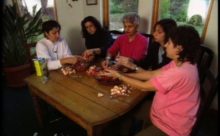Hamburger and Dolma, The Historical Background
Edited by Daniel W. Patterson
In Hamburger and Dolma children and grandchildren of survivors of the Armenian Genocide ponder ways in which their own lives were overshadowed by the events endured by their elders. The personal narrative of one of those survivors, shared by her granddaughter Julia Slayton, underscores the depth of the traumas of their elders. For an oral history project in 1975 Julia’s cousin Bethel Chakudian made a sound recording of the recollections of their grandmother Victoria Tatikian Nargesian. It has been posted on line and can be heard in the Digital Collections of the Columbia University Libraries.
The recording—spoken in English—is in three parts. In Part 1 Victoria Nargesian tells of the life she knew as a small child in Kozoluk, an Armenian village north of Tarsus in Turkey. Part 2 is a harrowing account of the 1909 massacre of most people in Kozoluk carried out by with impunity by Turks from a neighboring village. Part 3 tells how she, a child of nine, escaped and was taken in and cared for and schooled by American Missionaries with the Congregational Church in Adana, Turkey, and how she married and came to America.
Julia Slayton writes, “The Genocide remembrance often dates from 1915 to 1920, yet many villages and towns experienced massacres beginning in the late 1800s. My grandfather, who was also Armenian and from Marash, Turkey, experienced massacres in his village in 1896. He came to the U.S. with his mother and sister before the 1915 Genocide, and then went back with the French Army around 1917 to Turkey, met my grandmother, married, came to Newton, MA, around 1920, where they lived the rest of the lives. Thankfully she lived to be 96. They had 3 children and 8 grandchildren. One son, an Episcopal priest, another son, a harpsichord maker and musician, and a daughter, my mother, an artist.”
Julia describes her grandmother as “a person of extraordinary light and presence. She was filled with wonderful stories of her early childhood and family which perhaps were healing and grounding for her throughout her life. I grew up a few houses away from her – Her presence in my life was and continues to be a profound beautiful blessing.” In 2021 Julia looks back on the film itself as “a moving experience to make with these dear woman friends. Many of us have been meeting together for over 25 years.”
